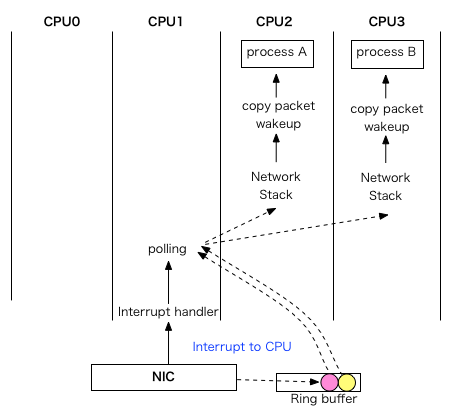1.背景
網路卡接收一個資料包的情況下,會經過三個階段:
- 網路卡產生硬體中斷通知CPU有包到達
- 通過軟中斷處理此資料包
- 在使用者態程式處理此資料包
在SMP體系下,這三個階段有可能在3個不同的CPU上處理,如下圖所示:

而RFS的目標就是增加CPU快取的命中率從而提高網路延遲。當使用RFS後,其效果如下:

2.實現原理
當使用者程式呼叫 revmsg() 或者 sendmsg()的時候,RFS會將此使用者程式執行的CPU id存入hash表;
而當有關使用者程式的資料包到達的時候,RFS嘗試從hash表中取出相應的CPU id, 並將資料包放置
到此CPU的佇列,從而對效能進行優化。
3.重要資料結構

/* * The rps_sock_flow_table contains mappings of flows to the last CPU * on which they were processed by the application (set in recvmsg). */ struct rps_sock_flow_table { unsigned int mask; u16 ents[0]; }; #define RPS_SOCK_FLOW_TABLE_SIZE(_num) (sizeof(struct rps_sock_flow_table) + \ ((_num) * sizeof(u16)))
結構體 rps_sock_flow_table 實現了一個hash表,RFS會將其宣告一個全域性變數用於存放所有sock對應的CPU。

/* * The rps_dev_flow structure contains the mapping of a flow to a CPU, the * tail pointer for that CPU's input queue at the time of last enqueue, and * a hardware filter index. */ struct rps_dev_flow { u16 cpu; //此鏈路上次使用的cpu u16 filter; unsigned int last_qtail; //此裝置佇列入隊的sk_buff的個數 }; #define RPS_NO_FILTER 0xffff /* * The rps_dev_flow_table structure contains a table of flow mappings. */ struct rps_dev_flow_table { unsigned int mask; struct rcu_head rcu; struct rps_dev_flow flows[0]; //實現hash表 }; #define RPS_DEV_FLOW_TABLE_SIZE(_num) (sizeof(struct rps_dev_flow_table) + \ ((_num) * sizeof(struct rps_dev_flow)))
結構體 rps_dev_flow_table 是針對一個裝置佇列
4.具體實現
使用者程式使用revmsg() 或者 sendmsg()的時候 設定CPU id。

int inet_recvmsg(struct kiocb *iocb, struct socket *sock, struct msghdr *msg, size_t size, int flags) { struct sock *sk = sock->sk; int addr_len = 0; int err; sock_rps_record_flow(sk); //設定CPU id err = sk->sk_prot->recvmsg(iocb, sk, msg, size, flags & MSG_DONTWAIT, flags & ~MSG_DONTWAIT, &addr_len); if (err >= 0) msg->msg_namelen = addr_len; return err; } EXPORT_SYMBOL(inet_recvmsg);
當有資料包進行了響應後,會呼叫get_rps_cpu()選擇合適的CPU id。其關鍵程式碼如下:

3117 hash = skb_get_hash(skb); 3118 if (!hash) 3119 goto done; 3120 3121 flow_table = rcu_dereference(rxqueue->rps_flow_table); //裝置佇列的hash表 3122 sock_flow_table = rcu_dereference(rps_sock_flow_table); //全域性的hash表 3123 if (flow_table && sock_flow_table) { 3124 u16 next_cpu; 3125 struct rps_dev_flow *rflow; 3126 3127 rflow = &flow_table->flows[hash & flow_table->mask]; 3128 tcpu = rflow->cpu; 3129 3130 next_cpu = sock_flow_table->ents[hash & sock_flow_table->mask]; //得到使用者程式執行的CPU id 3131 3132 /* 3133 * If the desired CPU (where last recvmsg was done) is 3134 * different from current CPU (one in the rx-queue flow 3135 * table entry), switch if one of the following holds: 3136 * - Current CPU is unset (equal to RPS_NO_CPU). 3137 * - Current CPU is offline. 3138 * - The current CPU's queue tail has advanced beyond the 3139 * last packet that was enqueued using this table entry. 3140 * This guarantees that all previous packets for the flow 3141 * have been dequeued, thus preserving in order delivery. 3142 */ 3143 if (unlikely(tcpu != next_cpu) && 3144 (tcpu == RPS_NO_CPU || !cpu_online(tcpu) || 3145 ((int)(per_cpu(softnet_data, tcpu).input_queue_head - 3146 rflow->last_qtail)) >= 0)) { 3147 tcpu = next_cpu; 3148 rflow = set_rps_cpu(dev, skb, rflow, next_cpu); 3149 } 3150 3151 if (tcpu != RPS_NO_CPU && cpu_online(tcpu)) { 3152 *rflowp = rflow; 3153 cpu = tcpu; 3154 goto done; 3155 } 3156 }
上面的程式碼中第3145行比較難理解,資料結構 softnet_data用於管理進出的流量,他有兩個關鍵的變數:

2374 #ifdef CONFIG_RPS 2375 /* Elements below can be accessed between CPUs for RPS */ 2376 struct call_single_data csd ____cacheline_aligned_in_smp; 2377 struct softnet_data *rps_ipi_next; 2378 unsigned int cpu; 2379 unsigned int input_queue_head; //佇列頭,也可以理解為出隊的位置 2380 unsigned int input_queue_tail; //佇列尾,也可以理解為入隊的位置 2381 #endif
表示式 (int)(per_cpu(softnet_data, tcpu).input_queue_head 求出了在tcpu 這個CPU上的出隊數目,而rflow->last_qtail
代表裝置佇列上此sock對應的最後入隊的位置,如果出隊數目大於入隊數目,那麼說明這一鏈路上的包都處理完畢,不會
出現亂序處理的包。第3143的if 語句就是為了防止亂序包的出現,假如是多程式或者多執行緒同時處理一個socket,那麼此
socket對應的CPU id就會不停變化。
參考文獻:
